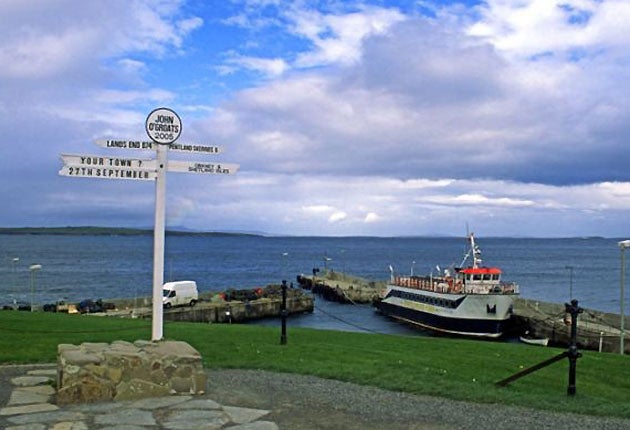Will the journey to John O’Groats finally be worth it?
£15m ‘Nordic’ makeover to banish image as Britain’s most disappointing attraction

Your support helps us to tell the story
From reproductive rights to climate change to Big Tech, The Independent is on the ground when the story is developing. Whether it's investigating the financials of Elon Musk's pro-Trump PAC or producing our latest documentary, 'The A Word', which shines a light on the American women fighting for reproductive rights, we know how important it is to parse out the facts from the messaging.
At such a critical moment in US history, we need reporters on the ground. Your donation allows us to keep sending journalists to speak to both sides of the story.
The Independent is trusted by Americans across the entire political spectrum. And unlike many other quality news outlets, we choose not to lock Americans out of our reporting and analysis with paywalls. We believe quality journalism should be available to everyone, paid for by those who can afford it.
Your support makes all the difference.It has laboured under the title of Britain’s most disappointing tourist attraction – a grand anti-climax after a long journey to nowhere. After more than a decade of neglect and dilapidation, the final piece in the jigsaw of the £15m plan to revitalise John O’Groats has been unveiled to the public.
The scheme will see the abandoned hotel restored as five-star holiday apartments, and 20 luxury eco-cabins with glass fronts will complete the “Nordic” harbour-side village feel, as well as affording sweeping views across the Pentland Firth.
Those who make the trip north will be encouraged to extend their stay – it currently averages little more than 10 minutes per tourist – with a new visitor centre telling the story of the eponymous Dutchman who operated the ferry across to Orkney and gave his name to both the area and the unit of currency he charged travellers.
But just as Jan de Groot struggled to reconcile the demands of his seven sons bidding to succeed him (eventually building an eight-sided house to control the rivalries of the warring siblings), so too have developers juggled the interests of the local community with the iconic status of the town as a world-famous destination.
The initial masterplan commissioned by the development agency Highlands and Islands Enterprise was criticised for “smothering the town in asphalt” and favouring the needs of the 112,000 annual visitors over its 300 residents.
But Andrew Mowat, who runs the local Seaview Hotel, said a public meeting held on Thursday night had been very supportive of the scheme: “It will certainly brighten the whole area up. I think it will be great for the local economy. I can’t see anyone really coming out against it now.”
John Glenday of Scotland’s Carbuncle Awards, which invites the public to nominate their least favourite buildings each year, described the plan as “a real chance for John O’Groats to pull itself together”.
“This is a more contemporary and intelligent response,” he said. “It creates a focus point for the town which it has lacked.” He added: “It is a damning indictment that people will travel for many hours to get there and often are too scared to get out of their car.”
Despite the magisterial scenery and extraordinary wildlife – it is one of the only places in the British Isles where killer whales can be observed from the shore – John O’Groats has been on the receiving end of vicious criticism. The Lonely Planet lambasted it as a “seedy tourist trap” while local politicians called it a “disgrace”. A public consultation on the latest proposal is due to be held in March.
Ian McKee, project manager, said he aimed to dispel the Marie Celeste atmosphere of the place: “You could well describe John O’Groats today as something of a ghost ship but with similar potential to create a really brilliant environment.”
The new leisure development and self-catering lodges will be run by Natural Retreats, which already operates a similar eco-friendly resort in the Yorkshire Dales National Park. The architect, GLM, was responsible for the redevelopment of Ackergill Tower, the former stronghold of the Earls of Caithness, which was recently sold for £5m.
The John O’Groats site is owned by Heritage Great Britain which also runs Lands End, the Needles Park on the Isle of Wight and the Snowdon Mountain Railway. Chief executive Allan Leech said he believed the new scheme would bring long-term social and economic benefits to the region.
Join our commenting forum
Join thought-provoking conversations, follow other Independent readers and see their replies
Comments